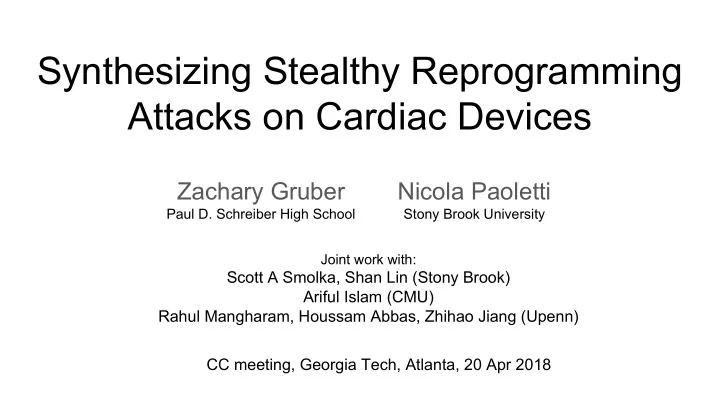

Synthesizing Stealthy Reprogramming Attacks on Cardiac Devices Zachary Gruber Nicola Paoletti Paul D. Schreiber High School Stony Brook University Joint work with: Scott A Smolka, Shan Lin (Stony Brook) Ariful Islam (CMU) Rahul Mangharam, Houssam Abbas, Zhihao Jiang (Upenn) CC meeting, Georgia Tech, Atlanta, 20 Apr 2018
What are ICDs? ● Implantable cardioverter defibrillator ○ 2 leads ○ 3 signals → atrial, ventricular, shock EGM ● Pacemaker and defibrillator function ● Prevent sudden death in patients ● Therapy ○ ATP - Antitachycardia pacing ○ High-energy shocks ● Needs to distinguish between VT and SVT ○ VT requires therapy. SVT does not. ○ Discrimination algorithm
Security Concerns ● Recently security calls by the FDA Homeland, “Broken Hearts” S2E10 ● Study: model-based reprogramming attacks on ICDs ○ By studying ICDs one can improve security down the road. Related work ● Reprogramming attacks via radio (D. Halperin et al., 2008) Analog Spoofing (M. Reynolds et al., 2013) ●
Synthesizing Stealthy Attacks on ICDs ● Reprogramming attack (manipulates ICD parameters) ● Two criteria - attack effectiveness and stealthiness ● Effectiveness: Effectiveness ○ Prevent necessary shocks ○ Induce unnecessary shocks ● Stealthiness: ○ Attack parameters close to the nominal parameters Parameter distance ○ Attack should go undetected in clinical visits → small (“inverse” of stealthiness) changes mistaken by clinician’s error
Methodology Overview ● Synthesis as multi-objective optimization (stealthiness and effectiveness are contrasting objectives) ● Model of ICD discrimination algorithm ● Model-based synthetic EGM signals ○ Poor availability of real patient signals ○ Allow to tailor the attack to the victim’s conditions ● Validation with unseen signals (mimicks unknown victim’s EGM)
Boston Scientific ICD Example of detection windows (BS ICD manual) Rhythm ID discrimination algorithm
Boston Scientific ICD Programmable parameters Rhythm ID discrimination algorithm
Open-loop EGM signals (Jiang et al. EMBC 2016) EGM signals
Attack effectiveness “An attack is effective on a signal if it prevents required therapy or introduces inappropriate therapy” Attack Set of signals True iff therapy is True iff therapy is parameters (training or test) given at any point in given at any point in s signal s under attack under nominal parameters p parameters p*
Attack effectiveness (example) Therapy signal with nominal parameters Therapy signal with attack parameters Heart cycles Heart cycles Therapy No therapy
Attack stealthiness “An attack is stealthy when the deviation from the nominal parameters is small” We quantify stealthiness as parameter distance (number of programmable values separating nominal and attack parameters) Example: parameter VT duration (s) Nominal parameters (distance 0) Attack parameters (distance 3)
Synthesis of optimal stealthy attacks Pareto-optimal Derive the set P of Pareto-optimal ICD parameters wrt effectiveness f e and distance f s objectives Effectiveness Sub-optimal Distance
Solution technique - optimization modulo theories (OMT) ● Optimization is challenging ○ nonlinear, non-convex, combinatorial, constrained by ICD algorithm ● SMT (SAT + theories) is well-suited to solve combinatorial problems ● SMT encoding of BS ICD algorithm: ○ formalization as a set FOL formulas over decidable theories (SMT QF_LIRA) ○ Efficient encoding: signal processing (e.g. peak detection) and nonlinear operations (e.g. correlation scores) not dependent on ICD parameters are precomputed ○ Parameter synthesis = finding a model, i.e., a SAT assignment of variables ● OMT = SMT + precise optimization (Bjørner et al. TACAS 2015, Sebastiani et al. CAV 2015) ○ to find the model (among all possible SAT assignments) that optimizes some objectives
OMT encoding (intuition) BMC-like formulation: Constraints for Unrolling of transition Initial state of programmable ICD algorithm relation describing ranges evolution of the ICD state on j-th signal between heart cycles ICD state for j-th signal and k-th heart cycle: In VF In VT Time Time duration? duration? spent in spent in VFd VTd
OMT encoding (intuition) Transition function: “If outside VF duration and no VF episodes are detected, then stay outside VF duration in the next state” “If a VF episode is detected and we are outside VF duration or VF duration just ended, then enter VF duration in the next state” ...
Evaluation, condition-specific attacks ● Use synthetic EGMs for 19 heart conditions ○ 100 EGMs for training (synthesis), 50 EGMs for validation (per condition) ● Attacks on VT-like conditions are all very effective ● But not all equally stealthy (see left) ● Common attack strategy: ○ Increase VT and VF detection thresholds in order to miss episodes ○ Increase VF and VT durations to reduce probability that Condition 10 Condition 17 episode is marked sustained (VT-like) (VT-like) Training signals Validation signals
Evaluation, condition-specific attacks Nominal parameters: EGM extract from condition 10 signals 1) VF duration start as 8/10 last ventricular intervals are below VF threshold 2) One interval is found below VF_th. Duration ends but can start right away, ending with therapy delivery ( T ) Attack parameters: 3) The episode is marked as VT and not VF (due to higher thresholds) 4) One interval is found below VT_th. VT duration ends but can start right away. Longer VT duration prevents therapy
Evaluation, condition-specific attacks ● Attacks on SVT-like conditions are not all equally effective ● Because, under normal HR, VT and VF must be reprogrammed to very low values to classify it as fast HR ● Common attack strategy: keep VF/VT thresholds and duration to a minimum Condition 5 Condition 11 (SVT-like) (SVT-like) Training signals Validation signals
Evaluation, condition-agnostic attacks ● Two groups of signals obtained by merging VT-like and SVT-like EGMs ○ Useful when the attacker has little knowledge of the victim ○ 200 EGMs for training, 100 EGMs for validation VT-like conditions SVT-like conditions
Conclusion ● Attacks on cardiac devices are a serious threat, see previous studies and device recalls by FDA ● We presented the first method to synthesize stealthy reprogramming attacks tailored to the victim’s conditions ● Employs synthetic EGMs and automated reasoning (OMT) to find malicious parameters with optimal effectiveness-stealthiness trade-offs ● Well generalizes to unseen data (mimicking unknown victim EGM) ● Future work: other ICD models, real patient EGMs, closed-loop interaction, spoofing attacks
Recommend
More recommend